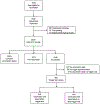Reduction in HPV 16/18-associated high grade cervical lesions following HPV vaccine introduction in the United States - 2008-2012
- PMID: 25681664
- PMCID: PMC7522784
- DOI: 10.1016/j.vaccine.2015.01.084
Reduction in HPV 16/18-associated high grade cervical lesions following HPV vaccine introduction in the United States - 2008-2012
Abstract
Background: Prevention of pre-invasive cervical lesions is an important benefit of HPV vaccines, but demonstrating impact on these lesions is impeded by changes in cervical cancer screening. Monitoring vaccine-types associated with lesions can help distinguish vaccine impact from screening effects. We examined trends in prevalence of HPV 16/18 types detected in cervical intraepithelial neoplasia 2, 3, and adenocarcinoma in situ (CIN2+) among women diagnosed with CIN2+ from 2008 to 2012 by vaccination status. We estimated vaccine effectiveness against HPV 16/18-attributable CIN2+ among women who received ≥1 dose by increasing time intervals between date of first vaccination and the screening test that led to detection of CIN2+ lesion.
Methods: Data are from a population-based sentinel surveillance system to monitor HPV vaccine impact on type-specific CIN2+ among adult female residents of five catchment areas in California, Connecticut, New York, Oregon, and Tennessee. Vaccination and cervical cancer screening information was retrieved. Archived diagnostic specimens were obtained from reporting laboratories for HPV DNA typing.
Results: From 2008 to 2012, prevalence of HPV 16/18 in CIN2+ lesions statistically significantly decreased from 53.6% to 28.4% among women who received at least one dose (Ptrend<.001) but not among unvaccinated women (57.1% vs 52.5%; Ptrend=.08) or women with unknown vaccination status (55.0% vs 50.5%; Ptrend=.71). Estimated vaccine effectiveness for prevention of HPV 16/18-attributable CIN2+ was 21% (95% CI: 1-37), 49% (95% CI: 28-64), and 72% (95% CI: 45-86) in women who initiated vaccination 25-36 months, 37-48 months, and >48 months prior to the screening test that led to CIN2+ diagnosis.
Conclusions: Population-based data from the United States indicate significant reductions in CIN2+ lesions attributable to types targeted by the vaccines and increasing HPV vaccine effectiveness with increasing interval between first vaccination and earliest detection of cervical disease.
Keywords: CIN; Cervical intraepithelial neoplasia; HPV; High grade cervical lesion; Human papillomavirus; Vaccine.
Published by Elsevier Ltd.
Conflict of interest statement
Conflict of interest
L. Niccolai was a consultant/advisory board member for Merck. All other authors declare no conflict of interest.
Figures


Comment in
-
No evidence in US of HPV16/18 cancer precursor reduction.Vaccine. 2016 Jan 4;34(2):200. doi: 10.1016/j.vaccine.2015.07.047. Epub 2015 Jul 29. Vaccine. 2016. PMID: 26232544 No abstract available.
-
Response to Pendleton et al. regarding reduction in HPV 16/18-associated high grade cervical lesions following HPV vaccine introduction in the United States.Vaccine. 2016 Jan 4;34(2):201. doi: 10.1016/j.vaccine.2015.10.138. Epub 2015 Dec 2. Vaccine. 2016. PMID: 26655631 No abstract available.
References
-
- Munoz N, Castellsague X, de Gonzalez AB, Gissmann L. Chapter 1: HPV in the etiology of human cancer. Vaccine 2006;24(Suppl. 3). S3/1-10. - PubMed
-
- Franco EL, Olsen J, Saracci R, Detels R. Epidemiology’s contributions to a Nobel Prize recognition. Epidemiology 2009;20:632–4. - PubMed
-
- de Sanjose S, Quint WG, Alemany L, Geraets DT, Klaustermeier JE, Lloveras B, et al. Human papillomavirus genotype attribution in invasive cervical cancer: a retrospective cross-sectional worldwide study. Lancet Oncol 2010;11:1048–56. - PubMed
-
- FUTURE I/II Study Group, Dillner J, Kjaer SK, Wheeler CM, Sigurdsson K, Iversen OE, et al. Four year efficacy of prophylactic human papillomavirus quadrivalent vaccine against low grade cervical, vulvar, and vaginal intraepithelial neoplasia and anogenital warts: randomised controlled trial. BMJ 2010;341:c3493. - PMC - PubMed
Publication types
MeSH terms
Substances
Grants and funding
LinkOut - more resources
Full Text Sources
Other Literature Sources
Medical

